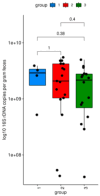Multiple Sclerosis and Clostridium perfringens Epsilon Toxin: Is There a Relationship?
- PMID: 39061966
- PMCID: PMC11274216
- DOI: 10.3390/biomedicines12071392
Multiple Sclerosis and Clostridium perfringens Epsilon Toxin: Is There a Relationship?
Abstract
Recent research has suggested a link between multiple sclerosis and the gut microbiota. This prospective pilot study aimed to investigate the composition of the gut microbiota in MS patients, the presence of Clostridium perfringens epsilon toxin in the serum of MS patients, and the influence of disease-modifying drugs (DMDs) on epsilon toxin levels and on the microbiota. Epsilon toxin levels in blood were investigated by two methods, a qualitative ELISA and a highly sensitive quantitative ELISA. Neither epsilon toxin nor antibodies against it were detected in the analyzed serum samples. 16S ribosomal RNA sequencing was applied to obtain insights into the composition of the gut microbiota of MS patients. No significant differences in the quantity, diversity, and the relative abundance of fecal microbiota were observed in the gut microbiota of MS patients receiving various DMDs, including teriflunomide, natalizumab, ocrelizumab, and fingolimod, or no therapy. The present study did not provide evidence supporting the hypothesis of a causal relationship between Clostridium perfringens epsilon toxin and multiple sclerosis.
Keywords: C. perfringens epsilon toxin; Clostridium perfringens; microbiota; multiple sclerosis.
Conflict of interest statement
F.B. declares no conflicts of interest. The funders had no role in the design of this study; in the collection, analyses, or interpretation of data; in the writing of the manuscript; or in the decision to publish the results. A.H. declares no conflicts of interest. H.T. has participated in meetings sponsored by or received honoraria for acting as an advisor/speaker for Alexion, Bayer, Biogen, Bristol-Myers Squibb, Celgene, Diamed, Fresenius, Fujirebio, GlaxoSmithKline, Horizon, Janssen-Cilag, Merck, Novartis, Roche, Sanofi-Genzyme, Siemens, and Teva.
Figures




Similar articles
-
Oral Multiple Sclerosis Drugs Inhibit the In vitro Growth of Epsilon Toxin Producing Gut Bacterium, Clostridium perfringens.Front Cell Infect Microbiol. 2017 Jan 25;7:11. doi: 10.3389/fcimb.2017.00011. eCollection 2017. Front Cell Infect Microbiol. 2017. PMID: 28180112 Free PMC article.
-
Is Clostridium perfringens epsilon toxin associated with multiple sclerosis?Mult Scler. 2023 Aug;29(9):1057-1063. doi: 10.1177/13524585231186899. Epub 2023 Jul 22. Mult Scler. 2023. PMID: 37480283 Free PMC article. Review.
-
Detection of Clostridium perfringens toxin genes in the gut microbiota of autistic children.Anaerobe. 2017 Jun;45:133-137. doi: 10.1016/j.anaerobe.2017.02.008. Epub 2017 Feb 17. Anaerobe. 2017. PMID: 28215985
-
Naturally acquired antibodies against Clostridium perfringens epsilon toxin in goats.Vet Immunol Immunopathol. 2008 Sep 15;125(1-2):198-202. doi: 10.1016/j.vetimm.2008.04.015. Epub 2008 Apr 29. Vet Immunol Immunopathol. 2008. PMID: 18538416
-
Disease-modifying therapy for multiple sclerosis: Implications for gut microbiota.Mult Scler Relat Disord. 2023 May;73:104671. doi: 10.1016/j.msard.2023.104671. Epub 2023 Mar 26. Mult Scler Relat Disord. 2023. PMID: 37001407 Review.
Cited by
-
Advances in Multiple Sclerosis.Biomedicines. 2025 Jan 22;13(2):266. doi: 10.3390/biomedicines13020266. Biomedicines. 2025. PMID: 40002680 Free PMC article.
-
Does Clostridium Perfringens Epsilon Toxin Mimic an Auto-Antigen Involved in Multiple Sclerosis?Toxins (Basel). 2025 Jan 7;17(1):27. doi: 10.3390/toxins17010027. Toxins (Basel). 2025. PMID: 39852980 Free PMC article.
References
-
- Berer K., Gerdes L.A., Cekanaviciute E., Jia X., Xiao L., Xia Z., Liu C., Klotz L., Stauffer U., Baranzini S.E., et al. Gut microbiota from multiple sclerosis patients enables spontaneous autoimmune encephalomyelitis in mice. Proc. Natl. Acad. Sci. USA. 2017;114:10719–10724. doi: 10.1073/pnas.1711233114. - DOI - PMC - PubMed
Grants and funding
LinkOut - more resources
Full Text Sources

